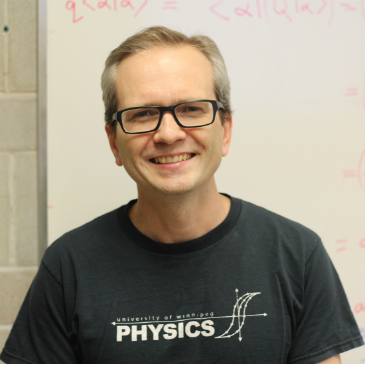
Dr. Jeff Martin, © UWinnipeg
Precision measurement of the proton’s weak charge narrows the search for new physics.
UWinnipeg’s physicist Dr. Jeffery Martin is one of the Canadian researchers that played a major role in an international collaboration that has gained new insight into the most elusive of the four fundamental forces in nature, the weak force. The Q-weak experiment has revealed the strength of the weak force’s grip on the proton, by measuring the proton’s weak charge to high precision. The research was carried out using the high quality polarized electron beam available at the Continuous Electron Beam Accelerator Facility, at the US Department of Energy’s Thomas Jefferson National Accelerator Facility. The result, published recently in Nature, also narrows the search for new particles that could influence the behavior of matter at very short distance scales.
“The UWinnipeg team was in charge of two major particle detectors that we built in order to carry out the experiment,” explains Martin. “Our contribution was an important part of the overall Canadian effort on this international science project. One of the detectors was totally novel, being made out of synthetic diamond and itself setting a new standard for precision measurements.”
The proton’s weak charge is analogous to its more familiar electric charge, a measure of the influence the proton experiences from the electromagnetic force. These two interactions are closely related in the Standard Model of particle physics, a highly successful theory that describes the electromagnetic and weak forces as two different aspects of a single force that interacts with subatomic particles. Despite its success, the Standard Model has a number of shortcomings, such as the large number of parameters that are constrained only by experiment, or the absence of a clear explanation for the existence of dark matter. The proton’s weak charge can be predicted very precisely in the Standard Model, and a precise measurement then can be used to look for hints of new physics, via deviations from the Standard Model prediction.
To measure the proton’s weak charge, an intense beam of electrons was directed onto a target containing cold liquid hydrogen, and the electrons scattered from this target were detected in a precise, custom-built measuring apparatus. The key to the Q-weak experiment is that the electrons in the beam were highly polarized – prepared prior to acceleration to be mostly “spinning” in one direction, parallel or anti-parallel to the beam direction. With the direction of polarization rapidly reversed in a controlled manner, the experimenters were able to latch onto the weak interaction’s unique property of parity (spatial inversion) violation, in order to isolate its tiny effects to high precision: a different scattering rate by about 2 parts in 10 million was measured for the two beam polarization states.
The proton’s weak charge was found to be QWp=0.0719±0.0045, which turned out to be in excellent agreement with predictions of the Standard Model, taking into account all known subatomic particles and the forces that act on them.
“Our new Q-weak result constrains predictions of hitherto unobserved heavy particles, that could play a role in weak interactions, such as those that may be produced by the Large Hadron Collider (LHC) at CERN in Europe or at future high energy particle
accelerators”, said Dr. Michael Gericke, a University of Manitoba member of the Canadian research team. “For example, Q-weak has set limits on the possible existence of leptoquarks — hypothetical particles that can reverse the identities of two broad classes of very different fundamental particles – turning quarks (the building blocks of nuclear matter) into leptons (electrons and their heavier counterparts) and vice versa.”
“The Q-weak experiment, initiated in 2001, represents the sustained effort of a large, international team of about 100 scientists from 25 institutions over nearly two decades”, said Dr. Shelley Page, a co-spokesperson and NSERC PI for the experiment. “The Canadian group was a founding member and represents approximately 15% of the Qweak collaboration; it was a leading contributor to the equipment design and construction, data production, and analysis efforts.”
More than $3M of support has been provided through the NSERC subatomic physics Project Grant program to the Canadian group, which includes scientists from the Universities of Manitoba, Northern BC, Winnipeg, and TRIUMF. These funds were used to build equipment and to support student and postdoctoral researchers’ salaries and travel to carry out the measurements at Jefferson Laboratory. Vital technical and engineering support was provided by TRIUMF, and detector development was carried out in CFI-funded laboratories at the Universities of Manitoba and Winnipeg. The Canadian group’s primary contributions include the design, fabrication, and field mapping of the large spectrometer magnet, the design and construction of the main electron detector package, development of a novel diamond microstrip detector used for precise Compton electron beam polarimetry, design and construction of low noise detector readout electronics, extensive systematic error simulations and data analysis.
The successful completion of the Q-Weak experiment is an important milestone in parity violating electroweak physics and sets the stage for a new measurement of the weak charge of the electron, at even higher precision – the MOLLER experiment – which is currently under development and in which a Canadian subatomic physics group from the University of Manitoba has again a strong position of leadership.
The experiment was funded by the United States Department of Energy, the National Science Foundation, the Natural Sciences and Engineering Research Council of Canada, and the Canadian Foundation for Innovation, with matching and in-kind
contributions from a number of the collaborating institutions.
Further Reading:
Proton’s Weak Charge Determined for First Time (Sept. 17, 2013)
Q-weak Backgrounder: Probing the Proton’s Weak Side
Getting a Better Measure of Spin with Diamond




